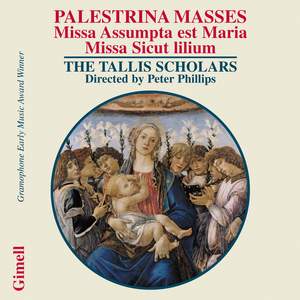Offer,Palestrina - Masses
The Tallis Scholars, Peter Phillips
In this recording of Missa Assumpta est Maria Peter Phillips has included the motet on which this work is based, together with another parody mass, the Sicut lilium with its corresponding motet.... — More…
CD
Original price ($15.75) Reduced price $12.50Downloads
What are FLAC and MP3?Contents
anon.: Assumpta est Maria
Work length7:43
$2.65
$3.25
- Rufus Müller (tenor)
- The Tallis Scholars
- Peter Phillips
Assumpta est Maria
Track length0:30
$1.05
$1.30
Assumpta est Maria
Track length7:13
$1.60
$1.95
Palestrina: Missa Assumpta est Maria
Work length29:47
$5.80
$7.15
- The Tallis Scholars
- Peter Phillips
I. Kyrie
Track length4:41
$1.05
$1.30
II. Gloria
Track length5:40
$1.05
$1.30
III. Credo
Track length8:06
$1.60
$1.95
IV. Sanctus and Benedictus
Track length5:30
$1.05
$1.30
V. Agnus Dei
Track length5:50
$1.05
$1.30
Palestrina: Sicut lilium inter spinas I
Work length4:42
$1.05
$1.30
- The Tallis Scholars
- Peter Phillips
Palestrina: Missa Sicut lilium inter spinas
Work length29:14
$5.80
$7.15
- The Tallis Scholars
- Peter Phillips
I. Kyrie
Track length3:42
$1.05
$1.30
II. Gloria
Track length6:11
$1.05
$1.30
III. Credo
Track length9:00
$1.60
$1.95
IV. Sanctus and Benedictus
Track length5:18
$1.05
$1.30
V. Agnus Dei
Track length5:03
$1.05
$1.30






